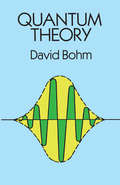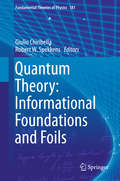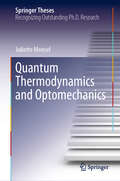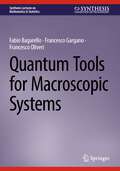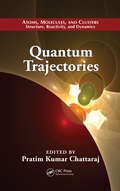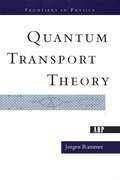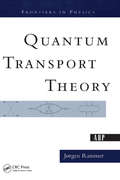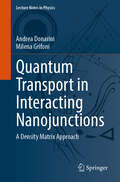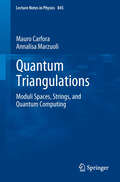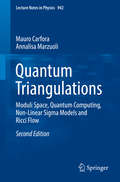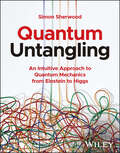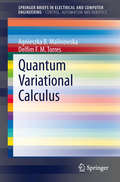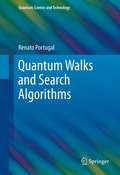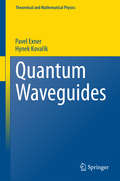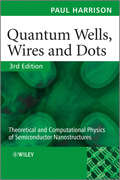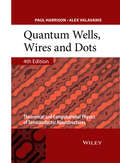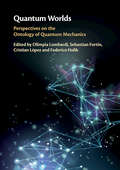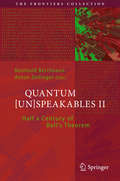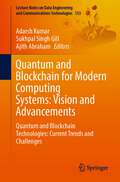- Table View
- List View
Quantum Theory: An Ontological Interpretation Of Quantum Theory (Dover Books on Physics)
by David BohmThis superb text by David Bohm, formerly Princeton University and Emeritus Professor of Theoretical Physics at Birkbeck College, University of London, provides a formulation of the quantum theory in terms of qualitative and imaginative concepts that have evolved outside and beyond classical theory. Although it presents the main ideas of quantum theory essentially in nonmathematical terms, it follows these with a broad range of specific applications that are worked out in considerable mathematical detail. Addressed primarily to advanced undergraduate students, the text begins with a study of the physical formulation of the quantum theory, from its origin and early development through an analysis of wave vs. particle properties of matter. In Part II, Professor Bohm addresses the mathematical formulation of the quantum theory, examining wave functions, operators, Schrödinger's equation, fluctuations, correlations, and eigenfunctions.Part III takes up applications to simple systems and further extensions of quantum theory formulation, including matrix formulation and spin and angular momentum. Parts IV and V explore the methods of approximate solution of Schrödinger's equation and the theory of scattering. In Part VI, the process of measurement is examined along with the relationship between quantum and classical concepts.Throughout the text, Professor Bohm places strong emphasis on showing how the quantum theory can be developed in a natural way, starting from the previously existing classical theory and going step by step through the experimental facts and theoretical lines of reasoning which led to replacement of the classical theory by the quantum theory.
Quantum Theory: Bullet Guides
by Jacob DunninghamOpen this book and you will: - Grasp quantum theory - Understand its importance - Examine paradoxes - Explore the atom
Quantum Theory: Bullet Guides
by Jacob DunninghamOpen this book and you will Grasp quantum theory Understand its importance Examine paradoxes Explore the atom
Quantum Theory: Informational Foundations and Foils
by Giulio Chiribella Robert W. SpekkensThis book provides the first unified overview of the burgeoning research area at the interface between Quantum Foundations and Quantum Information. Topics include: operational alternatives to quantum theory, information-theoretic reconstructions of the quantum formalism, mathematical frameworks for operational theories, and device-independent features of the set of quantum correlations. Powered by the injection of fresh ideas from the field of Quantum Information and Computation, the foundations of Quantum Mechanics are in the midst of a renaissance. The last two decades have seen an explosion of new results and research directions, attracting broad interest in the scientific community. The variety and number of different approaches, however, makes it challenging for a newcomer to obtain a big picture of the field and of its high-level goals. Here, fourteen original contributions from leading experts in the field cover some of the most promising research directions that have emerged in the new wave of quantum foundations. The book is directed at researchers in physics, computer science, and mathematics and would be appropriate as the basis of a graduate course in Quantum Foundations.
Quantum Thermodynamics and Optomechanics (Springer Theses)
by Juliette MonselThis thesis demonstrates the potential of two platforms to explore experimentally the emerging field of quantum thermodynamics that has remained mostly theoretical so far. It proposes methods to define and measure work in the quantum regime. The most important part of the thesis focuses on hybrid optomechanical devices, evidencing that they are proper candidates to measure directly the fluctuations of work and the corresponding fluctuation theorem. Such devices could also give rise to the observation of mechanical lasing and cooling, based on mechanisms similar to a heat engine. The final part of the thesis studies how quantum coherence can improve work extraction in superconducting circuits. All the proposals greatly clarify the concept of work since they are based on measurable quantities in state of the art devices.
Quantum Tools for Macroscopic Systems (Synthesis Lectures on Mathematics & Statistics)
by Fabio Bagarello Francesco Oliveri Francesco GarganoThis book describes how complex systems from a variety of fields can be modeled using quantum mechanical ideas; from biology and ecology, to sociology and decision-making. Quantum mechanics is traditionally associated with microscopic systems; however, quantum concepts have also been successfully applied to a wide range of macroscopic systems both within and outside physics. The mathematical basis of these models is covered in detail, providing a self-contained and consistent approach. This book provides unique insight into the dynamics of these macroscopic systems and opens new interdisciplinary research frontiers. The authors present an essential resource for researchers in applied mathematics or theoretical physics who are interested in applying quantum mechanics to complex systems in the social, biological or ecological sciences.Describes how complex systems from a variety of fields can be modeled using quantum mechanical ideasProvides insight into the dynamics of macroscopic systems and opens new interdisciplinary research frontiersIntroduces quantum tools needed for the analysis of the dynamical behavior of macroscopic systems
Quantum Trajectories (Atoms, Molecules, and Clusters)
by Pratim Kumar ChattarajThe application of quantum mechanics to many-particle systems has been an active area of research in recent years as researchers have looked for ways to tackle difficult problems in this area. The quantum trajectory method provides an efficient computational technique for solving both stationary and time-evolving states, encompassing a large area o
Quantum Transport
by Yuli V. Nazarov Yaroslav M. BlanterQuantum transport is a diverse field, sometimes combining seemingly contradicting concepts - quantum and classical, conduction and insulating - within a single nanodevice. Quantum transport is an essential and challenging part of nanoscience, and understanding its concepts and methods is vital to the successful fabrication of devices at the nanoscale. This textbook, first published in 2009, is a comprehensive introduction to the rapidly developing field of quantum transport. The authors present the comprehensive theoretical background, and explore the groundbreaking experiments that laid the foundations of the field. Ideal for graduate students, each section contains control questions and exercises to check readers' understanding of the topics covered. Its broad scope and in-depth analysis of selected topics will appeal to researchers and professionals working in nanoscience.
Quantum Transport Theory
by Jorgen RammerQuantum Transport Theory is a comprehensive account of recent achievements in the understanding of disordered conductors. Chapters cover the density matrix description of nonequilibrium statistical mechanics and newer topics in the field of condensed matter physics, including: weak localization; destruction of electronic phase coherence in disordered conductors; electron-electron and electron-phonon interaction in dirty metals; scaling theory of localization; the self-consistent theory of localization; and mesoscopic physics. The diagrammatic technique for systems out of equilibrium is developed systematically, and is used to study quantum kinetic equations and linear response theory.
Quantum Transport Theory
by Jorgen RammerQuantum Transport Theory is a comprehensive account of recent achievements in the understanding of disordered conductors. Chapters cover the density matrix description of nonequilibrium statistical mechanics and newer topics in the field of condensed matter physics, including: weak localization; destruction of electronic phase coherence in disordered conductors; electron-electron and electron-phonon interaction in dirty metals; scaling theory of localization; the self-consistent theory of localization; and mesoscopic physics. The diagrammatic technique for systems out of equilibrium is developed systematically, and is used to study quantum kinetic equations and linear response theory.
Quantum Transport Theory
by Jorgen RammerQuantum Transport Theory is a comprehensive account of recent achievements in the understanding of disordered conductors. Chapters cover the density matrix description of nonequilibrium statistical mechanics and newer topics in the field of condensed matter physics, including: weak localization; destruction of electronic phase coherence in disordered conductors; electron-electron and electron-phonon interaction in dirty metals; scaling theory of localization; the self-consistent theory of localization; and mesoscopic physics. The diagrammatic technique for systems out of equilibrium is developed systematically, and is used to study quantum kinetic equations and linear response theory.
Quantum Transport in Interacting Nanojunctions: A Density Matrix Approach (Lecture Notes in Physics #1024)
by Andrea Donarini Milena GrifoniThis book serves as an introduction to the growing field of quantum many-body transport in interacting nanojunctions. It delves into a theoretical approach based on a general density-matrix formulation for open quantum systems. In the book, relevant transport observables, like the current or its higher order cumulants, are obtained by evaluating quantum statistical averages. This approach requires the knowledge of the reduced density matrix of the interacting nanosystems. The formulation for addressing transport problems, based on the evolution of the reduced density operator in Liouville space, is highly versatile. It enables the treatment of charge and spin transport across various realistic nanostructures. Topics encompass standard Coulomb blockade, cotunneling phenomena in quantum dots, vibrational and Franck-Condon effects in molecular junctions, as well as many-body interference observed in double quantum dots or carbon nanotubes. Derived from lectures tailored for graduate and advanced students at the University of Regensburg in Germany, this book is enriched with exercises and step-by-step derivations.
Quantum Transport: Atom to Transistor
by Supriyo DattaThis 2005 book presents a unique approach to the fundamentals of quantum transport, and is aimed at senior undergraduate and graduate students. Some of the most advanced concepts of non-equilibrium statistical mechanics are included and yet no prior acquaintance with quantum mechanics is assumed. Chapter 1 provides a description of quantum transport in elementary terms accessible to a beginner. The book then works its way from the hydrogen atom to nanostructures ending with a unified model for quantum transport along with illustrative examples showing how conductors evolve from the atomic to the ohmic regime (or from 'atom to transistor') as they get larger. Many numerical examples are used to provide concrete illustrations and the corresponding MATLAB codes are provided in the book. These codes, along with videostreamed lectures by the author, keyed to specific sections of the book, are available at the webpage for the book - under 'resources and solutions'.
Quantum Triangulations
by Annalisa Marzuoli Mauro CarforaResearch on polyhedral manifolds often points to unexpected connections between very distinct aspects of Mathematics and Physics. In particular triangulated manifolds play quite a distinguished role in such settings as Riemann moduli space theory, strings and quantum gravity, topological quantum field theory, condensed matter physics, and critical phenomena. Not only do they provide a natural discrete analogue to the smooth manifolds on which physical theories are typically formulated, but their appearance is rather often a consequence of an underlying structure which naturally calls into play non-trivial aspects of representation theory, of complex analysis and topology in a way which makes manifest the basic geometric structures of the physical interactions involved. Yet, in most of the existing literature, triangulated manifolds are still merely viewed as a convenient discretization of a given physical theory to make it more amenable for numerical treatment. The motivation for these lectures notes is thus to provide an approachable introduction to this topic, emphasizing the conceptual aspects, and probing, through a set of cases studies, the connection between triangulated manifolds and quantum physics to the deepest. This volume addresses applied mathematicians and theoretical physicists working in the field of quantum geometry and its applications.
Quantum Triangulations
by Annalisa Marzuoli Mauro CarforaResearch on polyhedral manifolds often points to unexpected connections between very distinct aspects of Mathematics and Physics. In particular triangulated manifolds play quite a distinguished role in such settings as Riemann moduli space theory, strings and quantum gravity, topological quantum field theory, condensed matter physics, and critical phenomena. Not only do they provide a natural discrete analogue to the smooth manifolds on which physical theories are typically formulated, but their appearance is rather often a consequence of an underlying structure which naturally calls into play non-trivial aspects of representation theory, of complex analysis and topology in a way which makes manifest the basic geometric structures of the physical interactions involved. Yet, in most of the existing literature, triangulated manifolds are still merely viewed as a convenient discretization of a given physical theory to make it more amenable for numerical treatment. The motivation for these lectures notes is thus to provide an approachable introduction to this topic, emphasizing the conceptual aspects, and probing, through a set of cases studies, the connection between triangulated manifolds and quantum physics to the deepest. This volume addresses applied mathematicians and theoretical physicists working in the field of quantum geometry and its applications.
Quantum Untangling: An Intuitive Approach to Quantum Mechanics from Einstein to Higgs
by Simon SherwoodQuantum Untangling Non-technical and accessible primer providing key foundational knowledge on quantum mechanics and quantum field theory Quantum Untangling introduces the readers to the fascinating and strange realm of quantum mechanics and quantum field theory, written in an accessible manner while not shying away from using mathematics where necessary. The book goes into sufficient depth and conveys basic and more intricate concepts such as wave-particle duality, wave functions, the superposition principle, quantum tunneling, the quantum harmonic oscillator, the Dirac equation, and Feynman diagrams. It also covers the physics of the Higgs boson and provides a glimpse into string theory and loop quantum gravity. Overall, the author introduces complex concepts of quantum mechanics in an accessible and fun-to-read manner while laying the groundwork for mastering an advanced level of treatment in standard quantum mechanics textbooks and university courses. Quantum Untangling includes information on: Special relativity, time and length distortion, Einstein’s famous equation, how Einstein figured it out, and the implications for energy, mass and momentum Wave particle duality, discussing what classical physics cannot explain, quanta of light and the photoelectric effect, De Broglie’s crazy idea, and the double-slit experiment Making sense of Schrödinger’s equation, angular momentum and the wave function, angular rotational energy, atomic structure and molecular bonds Spin, Quantum Electrodynamics, gauge invariance, the strong and weak forces, plus a step-by-step description of the Higgs mechanism With Quantum Untangling, any reader with a good grasp of and an above-average interest in mathematics at advanced high-school level can follow the presentation and acquaint themselves with the fundamental and advanced topics of quantum mechanics and quantum field theory, making it a helpful resource for many different students.
Quantum Variational Calculus
by Agnieszka B. Malinowska Delfim F. M. TorresThis Brief puts together two subjects, quantum and variational calculi by considering variational problems involving Hahn quantum operators. The main advantage of its results is that they are able to deal with nondifferentiable (even discontinuous) functions, which are important in applications. Possible applications in economics are discussed. Economists model time as continuous or discrete. Although individual economic decisions are generally made at discrete time intervals, they may well be less than perfectly synchronized in ways discrete models postulate. On the other hand, the usual assumption that economic activity takes place continuously, is nothing else than a convenient abstraction that in many applications is far from reality. The Hahn quantum calculus helps to bridge the gap between the two families of models: continuous and discrete. Quantum Variational Calculus is self-contained and unified in presentation. It provides an opportunity for an introduction to the quantum calculus of variations for experienced researchers but may be used as an advanced textbook by graduate students and even ambitious undergraduates as well. The explanations in the book are detailed to capture the interest of the curious reader, and complete to provide the necessary background material needed to go further into the subject and explore the rich research literature, motivating further research activity in the area.
Quantum Walks and Search Algorithms
by Renato PortugalThis book addresses an interesting area of quantum computation called quantum walks, which play an important role in building quantum algorithms, in particular search algorithms. Quantum walks are the quantum analogue of classical random walks. It is known that quantum computers have great power for searching unsorted databases. This power extends to many kinds of searches, particularly to the problem of finding a specific location in a spatial layout, which can be modeled by a graph. The goal is to find a specific node knowing that the particle uses the edges to jump from one node to the next. This book is self-contained with main topics that include: Grover's algorithm, describing its geometrical interpretation and evolution by means of the spectral decomposition of the evolution operatorAnalytical solutions of quantum walks on important graphs like line, cycles, two-dimensional lattices, and hypercubes using Fourier transformsQuantum walks on generic graphs, describing methods to calculate the limiting distribution and mixing timeSpatial search algorithms, with emphasis on the abstract search algorithm (the two-dimensional lattice is used as an example)Szedgedy's quantum-walk model and a natural definition of quantum hitting time (the complete graph is used as an example)The reader will benefit from the pedagogical aspects of the book, learning faster and with more ease than would be possible from the primary research literature. Exercises and references further deepen the reader's understanding, and guidelines for the use of computer programs to simulate the evolution of quantum walks are also provided.
Quantum Walks and Search Algorithms (Quantum Science and Technology)
by Renato PortugalThe revised edition of this book offers an extended overview of quantum walks and explains their role in building quantum algorithms, in particular search algorithms.Updated throughout, the book focuses on core topics including Grover's algorithm and the most important quantum walk models, such as the coined, continuous-time, and Szedgedy's quantum walk models. There is a new chapter describing the staggered quantum walk model. The chapter on spatial search algorithms has been rewritten to offer a more comprehensive approach and a new chapter describing the element distinctness algorithm has been added. There is a new appendix on graph theory highlighting the importance of graph theory to quantum walks.As before, the reader will benefit from the pedagogical elements of the book, which include exercises and references to deepen the reader's understanding, and guidelines for the use of computer programs to simulate the evolution of quantum walks.Review of the first edition:“The book is nicely written, the concepts are introduced naturally, and many meaningful connections between them are highlighted. The author proposes a series of exercises that help the reader get some working experience with the presented concepts, facilitating a better understanding. Each chapter ends with a discussion of further references, pointing the reader to major results on the topics presented in the respective chapter.” - Florin Manea, zbMATH.
Quantum Waveguides
by Pavel Exner Hynek KovaříkThis monograph explains the theory of quantum waveguides, that is, dynamics of quantum particles confined to regions in the form of tubes, layers, networks, etc. The focus is on relations between the confinement geometry on the one hand and the spectral and scattering properties of the corresponding quantum Hamiltonians on the other. Perturbations of such operators, in particular, by external fields are also considered. The volume provides a unique summary of twenty-five years of research activity in this area and indicates ways in which the theory can develop further. The book is fairly self-contained. While it requires some broader mathematical physics background, all the basic concepts are properly explained and proofs of most theorems are given in detail, so there is no need for additional sources. Without a parallel in the literature, the monograph by Exner and Kovarik guides the reader through this new and exciting field.
Quantum Wells, Wires and Dots
by Paul HarrisonQuantum Wells, Wires and Dots, 3rd Edition is aimed at providing all the essential information, both theoretical and computational, in order that the reader can, starting from essentially nothing, understand how the electronic, optical and transport properties of semiconductor heterostructures are calculated. Completely revised and updated, this text is designed to lead the reader through a series of simple theoretical and computational implementations, and slowly build from solid foundations, to a level where the reader can begin to initiate theoretical investigations or explanations of their own.
Quantum Wells, Wires and Dots: Theoretical and Computational Physics of Semiconductor Nanostructures
by Paul Harrison Alex ValavanisQuantum Wells, Wires and Dots provides all the essential information, both theoretical and computational, to develop an understanding of the electronic, optical and transport properties of these semiconductor nanostructures. The book will lead the reader through comprehensive explanations and mathematical derivations to the point where they can design semiconductor nanostructures with the required electronic and optical properties for exploitation in these technologies. This fully revised and updated 4th edition features new sections that incorporate modern techniques and extensive new material including: - Properties of non-parabolic energy bands - Matrix solutions of the Poisson and Schrödinger equations - Critical thickness of strained materials - Carrier scattering by interface roughness, alloy disorder and impurities - Density matrix transport modelling -Thermal modelling Written by well-known authors in the field of semiconductor nanostructures and quantum optoelectronics, this user-friendly guide is presented in a lucid style with easy to follow steps, illustrative examples and questions and computational problems in each chapter to help the reader build solid foundations of understanding to a level where they can initiate their own theoretical investigations. Suitable for postgraduate students of semiconductor and condensed matter physics, the book is essential to all those researching in academic and industrial laboratories worldwide.
Quantum Worlds: Perspectives on the Ontology of Quantum Mechanics
by Olimpia Lombardi Sebastian Fortin Federico Holik Cristian LópezQuantum theory underpins much of modern physics and its implications draw the attention of industry, academia and public funding agencies. However there are many unsettled conceptual and philosophical problems in the interpretation of quantum mechanics which are a matter of extensive debate. These hotly debated topics include the meaning of the wave function, the nature of the quantum objects, the role of the observer, the non-locality of the quantum world, and the emergence of classicality from the quantum domain. Containing chapters written by eminent researchers from the fields of physics and philosophy, this book provides interdisciplinary, comprehensive and up-to-date perspectives of the problems related to the interpretation of quantum theory. It is ideal for academic researchers in physics and philosophy working on the ontology of quantum mechanics.
Quantum [Un]Speakables II
by Reinhold Bertlmann Anton ZeilingerThis self-contained essay collection is published to commemorate half a century of Bell's theorem. Like its much acclaimed predecessor "Quantum [Un]Speakables: From Bell to Quantum Information" (published 2002), it comprises essays by many of the worlds leading quantum physicists and philosophers. These revisit the foundations of quantum theory as well as elucidating the remarkable progress in quantum technologies achieved in the last couple of decades. Fundamental concepts such as entanglement, nonlocality and contextuality are described in an accessible manner and, alongside lively descriptions of the various theoretical and experimental approaches, the book also delivers interesting philosophical insights. The collection as a whole will serve as a broad introduction for students and newcomers as well as delighting the scientifically literate general reader.
Quantum and Blockchain for Modern Computing Systems: Quantum and Blockchain Technologies: Current Trends and Challenges (Lecture Notes on Data Engineering and Communications Technologies #133)
by Ajith Abraham Adarsh Kumar Sukhpal Singh GillThis book states that blockchain technology provides a secure distributed, peer-to-peer, and decentralized network with advanced cryptography primitives and protocols. The important question that arises in the quantum computing world is to test the existing blockchain networks against quantum attacks and design quantum computing enabled secure blockchain solutions. This book encourages professionals from different fields to provide blockchain and quantum technology-integrated solutions that incorporate low-cost, effective QoS, fast, secure, and futuristic demands. This book has surveyed and proposed approaches that improve quantum computing and cryptography protocols. Quantum computing and quantum science are not just helpful in software but the hardware world as well. To design networks with quantum science, quantum-enabled devices like quantum memories and quantum repeaters can be useful to demonstrate for organizations. For example, designing a single quantum repeater for long-distance quantum communication is useful in reducing the network cost, and ensuring better security levels. This book has introduced the quantum computing and blockchain technology aspects, their integration approaches and future directions.
